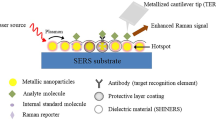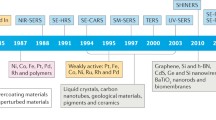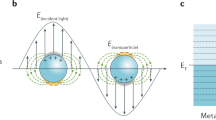Abstract
The surface-enhanced Raman spectroscopy (SERS) signal of a reporter on silver nanoparticles can be effectively gained by gradient electric field application. The external electric field initiates the dielectrophoresis of nanoparticles and their electrically induced dipole–dipole interaction. Owing to dielectrophoresis, the nanoparticles are concentrated in the area of high electrical field strength. The induced dipole–dipole interaction leads to additional coagulation of nanoparticles and formation of hotspots. Both dielectrophoresis and induced dipole–dipole interaction increase the number of hotspots, which leads to a SERS signal growth. These two mechanisms of SERS signal amplification are explained by the dielectrophoresis and Derjaguin–Landau–Verwey–Overbeek theories. The benefits of the surface-enhanced Raman spectroscopy in tandem with the gradient electric field are experimentally confirmed using a SERS-active reporter, 4-mercaptophenylboronic acid which has a characteristic peak at Raman shift of 1586 cm−1, conjugated to silver nanoparticles of 32, 52, 58, and 74 nm in diameter. The SERS signal gain depends on the silver nanoparticle stability, size, and electric field strength. The limit of detection for 4-mPBA in the system under study can be calculated from the concentration plot and equals to 63 nM. The enhancement factor calculated for SERS in tandem with the gradient electric field can reach 106.
Graphical abstract








Similar content being viewed by others
Data availability
The data that support the findings of this study are available from the corresponding author, Sorokina O.N., via e-mail: alsiona@gmail.com, upon reasonable request.
References
Nechaeva N, Prokopkina T, Makhaeva G, Rudakova E, Boltneva N, Dishovsky C, Eremenko A, Kurochkin I (2018) Quantitative butyrylcholinesterase activity detection by surface-enhanced Raman spectroscopy. Sensors Actuators B Chem 259:75–82. https://doi.org/10.1016/j.snb.2017.11.174
Durmanov NN, Guliev RR, Eremenko AV, Boginskaya IA, Ryzhikov IA, Trifonova EA, Putlyaev EV, Mukhin AN, Kalnov SL, Balandina MV, Tkachuk AP, Gushchin VA, Sarychev AK, Lagarkov AN, Rodionov IA, Gabidullin AR, Kurochkin IN (2018) Non-labeled selective virus detection with novel SERS-active porous silver nanofilms fabricated by electron beam physical vapor deposition. Sensors Actuators B Chem 257:37–47. https://doi.org/10.1016/j.snb.2017.10.022
Nechaeva NL, Boginskaya IA, Ivanov AV, Sarychev AK, Eremenko AV, Ryzhikov IA, Lagarkov AN, Kurochkin IN (2020) Multiscale flaked silver SERS-substrate for glycated human albumin biosensing. Anal Chim Acta 1100:250–257. https://doi.org/10.1016/j.aca.2019.11.072
Mosier-Boss PA (2017) Review of SERS substrates for chemical sensing. Nanomaterials 7. https://doi.org/10.3390/nano7060142
Hobro AJ, Lendl B (2010) SERS and separation science. In: Schlücker S (ed) Surface enhanced Raman spectroscopy: analytical. Wiley-VCH Verlag GmbH & Co. KGaA, Biophysical and Life Science Applications, pp 155–171. https://doi.org/10.1002/9783527632756
Wang K, Li S, Petersen M, Wang S, Lu X (2018) Detection and characterization of antibiotic-resistant Bacteria using surface-enhanced Raman spectroscopy. Nanomaterials. 8. https://doi.org/10.3390/nano8100762
Barik A, Cherukulappurath S, Wittenberg NJ, Johnson TW, Oh SH (2016) Dielectrophoresis-assisted Raman spectroscopy of intravesicular analytes on metallic pyramids. Anal Chem 88:1704–1710. https://doi.org/10.1021/acs.analchem.5b03719A
Sriram S, Bhaskaran M, Chen S, Jayawardhana S, Stoddart PR, Liu JZ et al (2012) Influence of electric field on SERS: frequency effects, intensity changes, and susceptible bonds. J Am Chem Soc. https://doi.org/10.1021/ja208893q
Walia S, Shah AK, Stoddart PR, Bhaskaran M, Sriram S (2015) Electric field induced surface-enhanced Raman spectroscopy for multianalyte detection. Phys Chem Chem Phys 17:7095–7099. https://doi.org/10.1039/c4cp04912h
Cheng IF, Chen TY, Lu RJ, Wu HW (2014) Rapid identification of bacteria utilizing amplified dielectrophoretic force-assisted nanoparticle-induced surface-enhanced Raman spectroscopy. Nanoscale Res Lett 9. https://doi.org/10.1186/1556-276X-9-324
Chrimes AF, Khoshmanesh K, Stoddart PR, Kayani AA, Mitchell A, Daima H, Bansal V, Kalantar-zadeh K (2012) Active control of silver nanoparticles spacing using dielectrophoresis for surface-enhanced Raman scattering. Anal Chem 84:4029–4035. https://doi.org/10.1021/ac203381n
Cherukulappurath S, Lee SH, Campos A, Haynes CL, Oh SH (2014) Rapid and sensitive in situ SERS detection using dielectrophoresis. Chem Mater 26:2445–2452. https://doi.org/10.1021/cm500062b
Almeida GB, Poppi RJ, da Silva JAF (2017) Trapping of Au nanoparticles in a microfluidic device using dielectrophoresis for surface enhanced Raman spectroscopy. Analyst. 142:375–379. https://doi.org/10.1039/c6an01497f
Chowdhury FK, Chappanda KN, Tabib-Azar M (2011) High enhancement SERS substrates created using DEP-DLA & annealing Au-W. In: Proceedings of IEEE Sensors. https://doi.org/10.1109/ICSENS.2011.6127243
Chrimes AF, Kayani AA, Khoshmanesh K, Stoddart PR, Mulvaney P, Mitchell A, Kalantar-zadeh K (2011) Dielectrophoresis-Raman spectroscopy system for analysing suspended nanoparticles. Lab Chip 11:921–928. https://doi.org/10.1039/c0lc00481b
Podoynitsyn SN, Tsyganova TV, Berezkin VV (2016) Separation of suspensions by dielectrophoresis on metal-coated track-etched membranes. Pet Chem 56:349–353. https://doi.org/10.1134/S0965544116040071
Podoynitsyn SN, Sorokina ON, Klimov MA, Levin II, Simakin SB (2019) Barrier contactless dielectrophoresis: a new approach to particle separation. Sep Sci Plus. https://doi.org/10.1002/sscp.201800128
Kretschmer R, Fritzsche W (2004) Pearl chain formation of nanoparticles in microelectrode gaps by dielectrophoresis. Langmuir. 20:11797–11801. https://doi.org/10.1021/la0482352
Leopold N, Lendl B (2003) A new method for fast preparation of highly surface-enhanced Raman scattering (SERS) active silver colloids at room temperature by reduction of silver nitrate with hydroxylamine hydrochloride. J Phys Chem B 107:5723–5727. https://doi.org/10.1021/jp027460u
Paramelle D, Sadovoy A, Gorelik S, Free P, Hobley J, Fernig DG (2014) A rapid method to estimate the concentration of citrate capped silver nanoparticles from UV-visible light spectra. Analyst. 139:4855–4861. https://doi.org/10.1039/c4an00978a
Zhang K, Zeng T, Tan X, Wu W, Tang Y, Zhang H (2015) A facile surface-enhanced Raman scattering (SERS) detection of rhodamine 6G and crystal violet using Au nanoparticle substrates. Appl Surf Sci 347:569–573. https://doi.org/10.1016/j.apsusc.2015.04.152
Bian Z, Liu A, Li Y, Fang G, Yao Q, Zhang G, Wu Z (2020) Boronic acid sensors with double recognition sites: a review. Analyst. https://doi.org/10.1039/C9AN00741E
Bell RA, Kramer JR (1999) Structural chemistry and geochemistry of silver-sulfur compounds: critical review. Environ Toxicol Chem 18:9–22. https://doi.org/10.1002/etc.5620180103
Kim DJ, Pitchimani R, Snow DE, Hope-Weeks LJ (2008) A simple method for the removal of thiols on gold surfaces using an NH4OH–H2O2–H2O solution. Scanning. 30:118–122. https://doi.org/10.1002/sca.20089
Cañamares MV, Garcia-Ramos JV, Sanchez-Cortes S, Castillejo M, Oujja M (2008) Comparative SERS effectiveness of silver nanoparticles prepared by different methods: a study of the enhancement factor and the interfacial properties. J. Colloid Interface Sci doi 326:103–109. https://doi.org/10.1016/j.jcis.2008.06.052
Keskin S, Çulha M (2012) Label-free detection of proteins from dried-suspended droplets using surface enhanced Raman scattering. Analyst 2012(137):2651–2657. https://doi.org/10.1039/C2AN16296B
Code availability
Not applicable.
Funding
This work was performed under the Russian Federation State Assignment no АААА-А19-119071890024-8 and AAAA-A19-119110790066-5.
Author information
Authors and Affiliations
Contributions
S.N. Podoynitsyn—theoretical discussion; O.N. Sorokina, N.L. Nechaeva—experimental setup and results discussion; S. V. Yanovich—computer modelling; I. N. Kurochkin—research management and consulting
Corresponding author
Ethics declarations
Conflict of interest
The authors declare that they have no conflict of interest.
Additional information
Publisher’s note
Springer Nature remains neutral with regard to jurisdictional claims in published maps and institutional affiliations.
Electronic supplementary material
ESM 1
(PDF 804 kb)
Rights and permissions
About this article
Cite this article
Podoynitsyn, S.N., Sorokina, O.N., Nechaeva, N.L. et al. Surface-enhanced Raman spectroscopy in tandem with a gradient electric field from 4-mercaptophenylboronic acid on silver nanoparticles. Microchim Acta 187, 566 (2020). https://doi.org/10.1007/s00604-020-04550-x
Received:
Accepted:
Published:
DOI: https://doi.org/10.1007/s00604-020-04550-x




